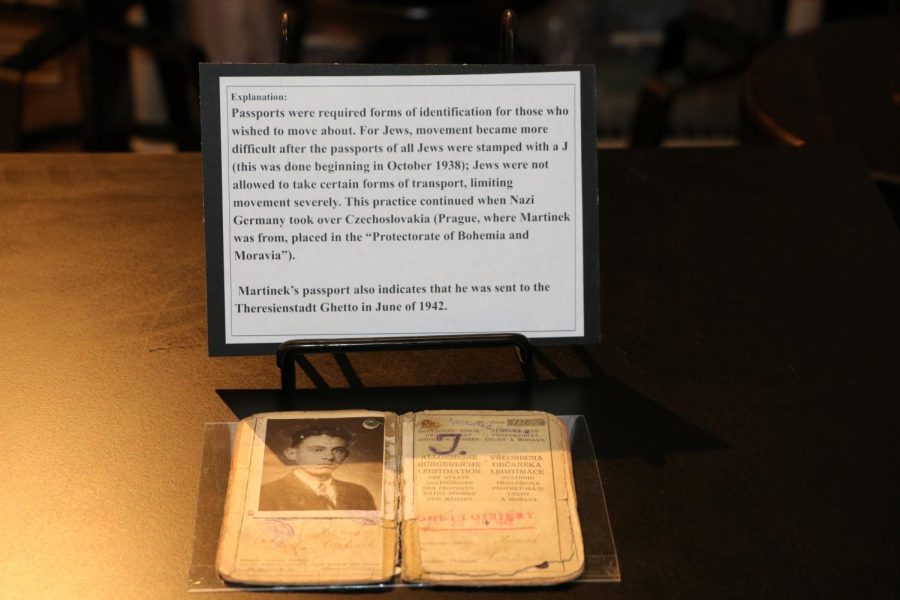CESJDS educates on the Holocaust in new, interactive way this Yom HaShoah
May 2, 2019
In addition to CESJDS’ annual commemoration programs that are typical on Yom HaShoah, the school explored a new way to teach students about the Holocaust this year. To further the way students learn about the Holocaust, high school students explored an exhibit of Holocaust artifacts during their second period as an educational component of the day.
The family of sixth-grader Max Weitzner and sophomore Jack Weitzner donated a number of artifacts to the exhibit from a collection that the Weitzners’ grandfather put together many years ago. They mainly consisted of personally identifying documents and other items.
“The Jewish History department helped select the artifacts being shown, and they are meant to get students to think about the people who were in these situations and thus make it a more personal, relatable experience,” Jack said.
The Weitzner family has donated other artifacts, such as uniforms and soup cups, to the Lower School for Yom HaShoah in the past. However, Jack feels that this year’s exhibit at the Upper School is unique because of the difference in artifacts and how they are going to be displayed.
“The Lower School focused on the Holocaust more broadly, but this year the goal of the exhibit is to show the lives of just a few people in a deep way as opposed to showing six million people in a non-specific and overwhelming way,” Jack said.
Weitzner sees the goal of the collection as being a better way to educate students on Yom Hashoah because it gives people the opportunity to see unique items and learn about their significance to the Jews during the Holocaust.
“The JDS community, being mostly teenagers, is the community who will be growing up and starting to see the Holocaust as ‘history,’ and the idea is to make a connection to make it more relevant,” Jack said. “It’s our history, and eventually today’s students will be the ones who have had the opportunity to hear about it first-hand from survivors and see the artifacts, which is important in having a good understanding.”
The mini-museum of artifacts is part of the overall development of how JDS presents information about the Holocaust to students. Director of Jewish Life Stephanie Hoffman hopes that the artifact exhibit will teach students about it in a new way based on research recent research.
“In the last 25-30 years, educators have really been talking about what is really educationally appropriate: what is developmentally appropriate at different stages when we talk about Holocaust education,” Hoffman said. “Our high schoolers are going to be seeing the artifacts and walking through and actually looking at real pieces from our history.”
After completing a unit on the Holocaust in the Modern Jewish History course, each sophomore class plans the Tekes memorial ceremony for middle school and high school, the vigil and the educational aspect, which was the museum exhibit this year.
During the formal memorial ceremony, students presented images from the Holocaust and information about it. Sophomore Sami Himmelfarb was part of the group that planned the Tekes ceremony, as well as one of the student docents for the mini-museum. Himmelfarb feels it is an important and valuable experience to help plan a day of learning like this.
“I think [planning this is] one of the important parts of [the day] because it shows us what we learned and our Jewish values in planning something like this and how we use the information to inform and teach others about the Holocaust,” Himmelfarb said.
The sophomore class-ran vigil dedicated by the Bassin family in honor of eighth-grader Jonah Bassin and sophomore Addie Bassin’s grandfather Morley Potash. The vigil had a constant reading of names of Holocaust victims from 7:30 a.m. to 4:30 p.m. in the Exhibition Hall.
Jewish History teacher Dan Rosenthal is a JDS alumnus and has experienced many Yomim Hashoah in the building. In his days as a student, he says the school did something very similar to what the school does now to commemorate the Holocaust. He feels that integrating students into the planning process with teachers is important when creating a successful, meaningful and educational day of remembrance about both Jewish history and the Holocaust.
“A partnership is best because students need to show initiative to take ownership of these things and would need guidance,” Rosenthal said. “It’s a really hard balance to strike between commemoration of the Holocaust and marking other events in Jewish history, and we try to make the community as aware about all of the necessary historical context behind this day because it is so important.”








